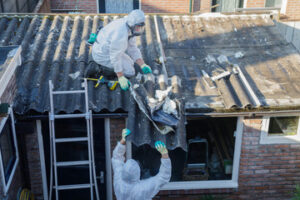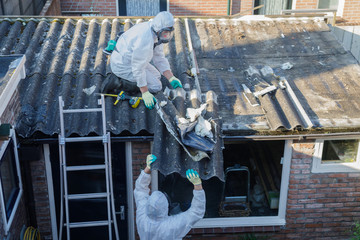Asbestos is a toxic substance that medical professionals link to a variety of ailments. This naturally occurring mineral is found in a number of materials used in home construction, such as floor tiles, roofing and insulation.
To ensure your asbestos removal is done correctly, follow these guidelines. Also, get in touch with your local and state departments of environmental quality for regulations you must abide by during abatement. Visit https://www.perthasbestosremovalwa.com.au/ to learn more.

Asbestos is a fibrous natural mineral that was once widely used in building materials, including insulation, floor and ceiling tiles, roofing shingles and pipes. However, it is now known to cause lung cancer and other respiratory diseases. Because of the risk, state and local governments have regulations in place to protect public health.
Most states require a permit for asbestos removal and construction projects that involve asbestos. Local townships and boroughs may also have their own requirements for the handling of asbestos. In most cases, a professional must do the work to avoid contamination and ensure that the process is done properly.
The state Department of Environmental Protection (DEP) regulates abatement, construction and demolition projects that involve asbestos. To obtain a permit, the building or property owner must submit a complete Work Practices Standard Plan (WPSP) to DEP’s Asbestos Technical Review Unit. An independent air-monitoring firm must also be hired to monitor work activities and the release of asbestos fibers into the air.
Once the WPSP is approved, the building or property owner must post it at the work site along with a copy of the abatement permit. Work cannot begin until the permit has been issued and posted with a specified start date. The permit must be accompanied by an abatement plan and any required documentation, including a list of the non-asbestos contractors who will perform the work. In addition, the WPSP must include a tenant protection plan to prevent contamination of residential units occupied during the course of the project.
The regulating body should visit the work site when the project begins to ensure that all work is being conducted according to the standards set forth in the WPSP. For lengthy jobs where the disturbance of ACM is likely, inspections should be made on a regular basis throughout the duration of the job to determine whether any changes are needed to the work practices and abatement procedures.
The DEP also requires that a certified industrial hygienist or other certified professional examine the work area for airborne concentrations of asbestos. The hygienist will record his or her observations on the Evaluation of Work Affecting Asbestos Form, and should note any deviations from the standard and approved work practices. The completed form should be submitted to the DEP’s online Asbestos Reporting and Tracking System (ARTS).
Asbestos is a naturally occurring mineral that was once used in thousands of products ranging from insulation to cement wallboard. It is now known to cause lung cancer and mesothelioma, and it must be handled carefully by professionals under controlled conditions. When a contractor arrives at your home to remove asbestos, they will set up a decontamination enclosure and turn off the heating and air conditioning system. They will also put up plastic sheeting and duct tape to seal the work area. They may also wet the area or use a HEPA vacuum cleaner to keep asbestos fibers from spreading to other parts of the house.
Assure that the contractor uses a face mask and full-body protective suit. They should also wear rubber gloves and a clean work uniform. Poly sheeting is also often used to contain the workspace and prevent airborne asbestos from escaping to other areas of the house. If your contractor is working in your attic or another area of the house that you frequent, ask them to protect those spaces with plastic sheeting and duct tape.
Before the work starts, get a written contract specifying the work plan, cleanup requirements and the federal, state and local regulations that the contractor must follow. Inquire about the contractor’s experience with the type of work you need done, and ask them to provide references from previous clients.
A low risk asbestos job does not require a permit, but a licensed asbestos professional should be used for any high-risk jobs. People who are likely to disturb asbestos containing materials such as roofers and demolition workers should receive practical training specific to the risks associated with their work.
Asbestos material that is in good condition does not pose a danger unless it is disturbed. It is dangerous only if the fibers become airborne and are inhaled into the lungs. It is important to check the condition of asbestos regularly and have it removed if it becomes damaged, or if the material has been exposed to extreme vibration or air flow. Other factors that can influence whether a specific asbestos material should be removed include its location, what it’s being used for and what kind of work is being performed on the structure.
Asbestos can be removed from a property safely by professionals, or by homeowners with the right training and equipment. However, the material must be properly disposed of. If not disposed of properly, asbestos waste can cause breathing problems for people who live or work near it. This is why federal, state and local governments regulate the handling of asbestos-containing materials. They set standards for the disposal of asbestos to protect the public from airborne contaminants that can lead to lung diseases such as mesothelioma, asbestosis and lung cancer.
Workers must wear a respirator when working with asbestos-containing material. They also use protective clothing, which includes disposable coveralls and head covers made of a synthetic fabric that doesn’t allow asbestos fibers to pass through. Workers are required to double bag the asbestos-containing material before throwing it away in special landfills that have been approved for asbestos waste.
The work area is enclosed in a decontamination unit that has a sealed door and plastic sheeting to prevent the spread of asbestos dust. The work area must be completely isolated from the occupied areas of the building, such as living rooms, kitchens and bathrooms. If the work involves removing asbestos from pipes, the contractor must wet down the pipe lagging before removing it.
In addition to minimizing the release of asbestos fibers, workers must also take steps to minimize any disruption to routine custodial and maintenance activities. These procedures should be implemented depending on the likelihood of disturbing ACM and releasing fibers.
These procedures can include the following:
During the asbestos abatement process, you should make sure that the professional you hire is reputable and has an outstanding reputation for professionalism. Get multiple bids and choose a contractor based on an overall evaluation of services, not just cost. Before the project starts, get a written contract specifying the work plan and cleanup procedures. Ask the contractor to describe his or her qualifications and licensing. You can also consider hiring a monitoring firm that has no financial relationship with the abatement company to oversee the removal.
Asbestos is a naturally occurring mineral, very strong and heat resistant. It was used in over three thousand different building materials and products including pipe insulation, cement wallboard, roofing shingles, fireproof cloth, vermiculite attic insulation and automotive brakes. It has been proven to cause lung cancer, asbestosis and mesothelioma. It should never be touched or disturbed by anyone except under controlled conditions.
Most asbestos is found in building materials that are not intended to be removed. However, if these materials become damaged during remodeling or other renovations they can release asbestos fibers into the air. These fibers can be inhaled and ingested and are the source of exposure to asbestos. Exposure can also occur when a building is demolished and asbestos-containing materials are disturbed.
It is important to have a professional inspect the suspected material and take samples if necessary. These samples must be handled by a licensed asbestos professional. Samples can be taken with a handheld vacuum or a dry wipe method. When a sample is taken it must be placed in a clean container such as a 35 mm film canister, glass or plastic vial and a high quality resealable plastic bag. Samples should be stored in a secure area and should not be exposed to air, sunlight or moisture.
Asbestos in good condition is generally not a health risk. If it is heavily damaged and crumbling, a licensed asbestos professional should be called in for inspection and corrections.
